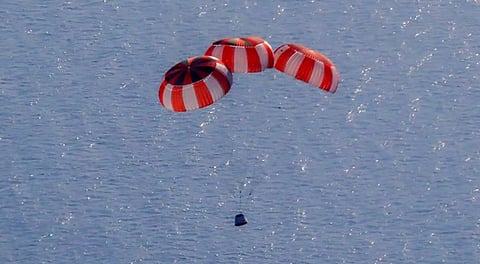

Bengaluru | ISRO on Tuesday said it has successfully conducted an important test on main parachutes for the Gaganyaan Crew Module at the Babina Field Firing Range (BFFR) in Uttar Pradesh's Jhansi on November 3.
The Indian space agency said this test is part of the ongoing series of Integrated Main Parachute Airdrop Tests (IMAT) for the qualification of the parachute system for the Gaganyaan mission.
The Gaganyaan mission is India's first human spaceflight programme, aiming to send a three-member crew on a three-day mission to space and return them safely to Earth.
As part of the mission, ISRO is developing a human-rated launch vehicle, an orbital module, and a crew-escape system. The programme includes prior unmanned missions to test critical systems before the first manned flight.
In a statement, ISRO said that for the Gaganyaan Crew Module, the parachute system comprises a total of 10 parachutes of four types.
It added that the descent sequence begins with two apex cover separation parachutes that remove the protective cover of the parachute compartment, followed by two drogue parachutes (small powerful parachute deployed from a fast moving object to slow it down) that stabilise and decelerate the module.
Upon release of the drogues, three pilot parachutes are deployed to extract three main parachutes, which further slow down the Crew Module to ensure a safe touchdown, ISRO said.
"The system is designed with redundancy—two of the three main parachutes are sufficient to achieve a safe landing. The main parachutes of the Gaganyaan mission deploy in a step-by-step process known as reefed inflation," ISRO said.
In this process, the parachute first opens partially, which is called reefing, and then fully opens after a predetermined period of time, known as disreefing. This process is carried out using pyro device, it explained.
A pyro device, short for pyrotechnic device, is any mechanism that uses controlled combustion or an explosive chemical reaction to perform a specific function, usually to generate gas, pressure, heat, light, or motion.
"In this test, one of the possible extreme scenarios of delay in the disreefing between the two main parachutes was successfully demonstrated validating the main parachutes for the maximum design," ISRO said.
"The test evaluated the system’s structural integrity and load distribution under asymmetric disreefing conditions—one of the most critical load scenarios expected during actual mission descent," the agency said.
A simulated mass equivalent to the Crew Module was dropped from an altitude of 2.5 km using the Indian Air Force’s IL-76 aircraft, it said, adding the parachute system deployed as planned and the sequence was executed flawlessly, and the test article achieved a stable descent and soft landing, validating the robustness of the parachute design.
"The successful completion of this test marks another significant step toward qualifying the parachute system for human spaceflight, with active participation from the Vikram Sarabhai Space Centre (VSSC), ISRO, Aerial Delivery Research and Development Establishment (ADRDE), DRDO, Indian Air Force and the Indian Army," ISRO said.
